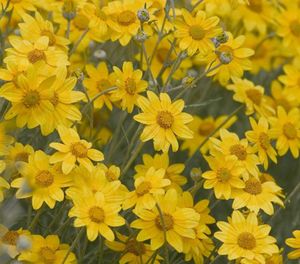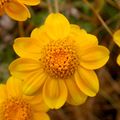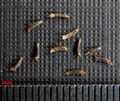Difference between revisions of "Eriophyllum lanatum"
(→Habitat) |
(→Uses) (Tag: VisualEditor) |
||
| Line 26: | Line 26: | ||
===Description=== | ===Description=== | ||
| − | + | Silvery-woolly perennial herb, often with several stems, growing to 60 cm tall.<ref name=":1">Bowcutt, F., & | |
| − | + | Hamman, S. (2016). ''Vascular Plants | |
| − | Leaves | + | of the South Sound Prairies''. p. 72.</ref> Leaves usually opposite, sometimes alternate,<ref name=":1" /> entire to pinnatifid, to 8 cm long.<ref name=":0">WTU Herbarium, Burke Museum, & University of Washington. Retrieved from http://biology.burke.washington.edu/herbarium/imagecollection/taxon.php?Taxon=Eriophyllum%20lanatum</ref> Pseudanthia radiate, usually solitary and long-pedunculate;<ref>Flora of North America. Retrieved |
| − | + | from http://dev.floranorthamerica.org/Eriophyllum_lanatum</ref> phyllaries broad, involucre 6-12 mm tall;<ref name=":0" /> ray florets 4-13, yellow and fertile; disk florets yellow, fertile; pappus of chaffy scales;<ref name=":2">Hitchcock, C. L., Cronquist, A., Giblin, D., | |
| − | + | & Legler, B. et al. (2018). ''Flora of the Pacific Northwest: an | |
| − | + | illustrated manual''. Seattle: University of Washington Press. pp. 577-578.</ref> style branched, stigmas 2,<ref name=":2" /> ovary inferior, becoming slender, 4-angled achenes.<ref name=":0" /> | |
===Bloom Period=== | ===Bloom Period=== | ||
| Line 40: | Line 40: | ||
===Habitat=== | ===Habitat=== | ||
| − | + | Low to high elevation open areas that are dry and often rocky.<ref name=":0" /> | |
===Uses=== | ===Uses=== | ||
Wildlife: Butterflies - attracts orange sulfur red admiral comma and skipper butterflies.<ref>Native Plants of North America. Retrieved from https://www.wildflower.org/plants/result.php?id_plant=erla6</ref> | Wildlife: Butterflies - attracts orange sulfur red admiral comma and skipper butterflies.<ref>Native Plants of North America. Retrieved from https://www.wildflower.org/plants/result.php?id_plant=erla6</ref> | ||
| + | |||
| + | First Nations: Miwok use as a poultice for treating aches; Skagit use of leaves to prevent chapping; Chehalis use of dried leaves as a love medicine.<ref>Native | ||
| + | American Ethnobotany Database. Retrieved from http://naeb.brit.org/uses/search/?string=Eriophyllum+lanatum | ||
| + | </ref> | ||
===Propagation=== | ===Propagation=== | ||
| Line 57: | Line 61: | ||
Care requirements after installed: Good drought tolerance, no after care with appropriate planting time. | Care requirements after installed: Good drought tolerance, no after care with appropriate planting time. | ||
Normal rate of growth or spread; lifespan: Rapidly occupies a restoration site. Long-lived.<ref>University of Washington. Retrieved from https://depts.washington.edu/propplnt/Plants/Eriophyllum%20lanatum.htm</ref> | Normal rate of growth or spread; lifespan: Rapidly occupies a restoration site. Long-lived.<ref>University of Washington. Retrieved from https://depts.washington.edu/propplnt/Plants/Eriophyllum%20lanatum.htm</ref> | ||
| + | |||
| + | [https://npn.rngr.net/search/search?SearchableText=Eriophyllum+lanatum Native Plant Network Propagation Protocol] | ||
===Photo Gallery=== | ===Photo Gallery=== | ||
<gallery> | <gallery> | ||
Latest revision as of 13:02, 29 June 2021
- Scientific Name: Eriophyllum lanatum
- Family: Asteraceae
- Common Names: common woolly sunflower
- Codon: ERILAN
Contents
Taxonomy
| Scientific classification | |
|---|---|
| Kingdom: | Plantae |
| Subkingdom: | Viridiplantae |
| Phylum: | Tracheophyta |
| Subphylum: | Spermatophytina |
| Class: | Magnoliopsida |
| Subclass: | Asteranae |
| Order: | Asterales |
| Family: | Asteraceae |
| Genus: | Eriophyllum Lag. |
| Species: | Eriophyllum lanatum (Pursh) Forbes |
Description
Silvery-woolly perennial herb, often with several stems, growing to 60 cm tall.[2] Leaves usually opposite, sometimes alternate,[2] entire to pinnatifid, to 8 cm long.[3] Pseudanthia radiate, usually solitary and long-pedunculate;[4] phyllaries broad, involucre 6-12 mm tall;[3] ray florets 4-13, yellow and fertile; disk florets yellow, fertile; pappus of chaffy scales;[5] style branched, stigmas 2,[5] ovary inferior, becoming slender, 4-angled achenes.[3]
Bloom Period
May-August[3]
Distribution
Common on both sides of the Cascades from British Columbia to California, east to Montana and Utah.[3]
Habitat
Low to high elevation open areas that are dry and often rocky.[3]
Uses
Wildlife: Butterflies - attracts orange sulfur red admiral comma and skipper butterflies.[6]
First Nations: Miwok use as a poultice for treating aches; Skagit use of leaves to prevent chapping; Chehalis use of dried leaves as a love medicine.[7]
Propagation
May be collected as: Seeds. Collect whole fruiting heads when fruit is completely ripe from mid-summer to early fall. Collection restrictions or guidelines: None: common and unlisted Seed germination: Good germination after cold storage and fall planting in cold frames Seed life: Many years when well stored Recommended seed storage conditions: Dry down to 5-8% moisture. Store cold at 0-2°C. Propagation recommendations: Good germination from seed. Soil or medium requirements: Recommendation 1:1:1:2 sand:pumice:peat moss:fir bark Installation form: Direct seeding into site may reduce seedling dormancy or loss. Recommended planting density: Dense and patchy Care requirements after installed: Good drought tolerance, no after care with appropriate planting time. Normal rate of growth or spread; lifespan: Rapidly occupies a restoration site. Long-lived.[8]
Native Plant Network Propagation Protocol
Photo Gallery
References
-Archibald C. 2006. Seed production protocols for Anaphalis margaritacea, Eriophyllum lanatum, and Eriogonum umbellatum. Native Plants Journal 7(1):47–51. -Burke Museum of Natural History and Culture, 2006, http://biology.burke.washington.edu/herbarium/imagecollection.php?Genus=Eriophyllum&Species=lanatum&Trinomial=lanatum -Hunt, John W.; Boul , Rachelle D. ; Brown , Matthew R. ; Koenig , David A.; Leigh , Mark ; Pushnik, James C. 2006. Propagation protocol for production of container Eriophyllum lanatum plants (Potted nursery stock ); CSU, Chico Research Foundation, Chico, California. In: Native Plant Network. URL: http://www.nativeplantnetwork.org (accessed 11 April 2006). Moscow (ID): University of Idaho, College of Natural Resources, Forest Research Nursery. -Klinkenberg, Brian. (Editor) 2004. E-Flora BC: Electronic Atlas of the Plants of British Columbia [www.eflora.bc.ca]. Lab for Advanced Spatial Analysis, Department of Geography, University of British Columbia, Vancouver. -Kozloff, E., 2005. “Plants of Western Oregon, Washington and British Columbia”, Timber Press, Portland -The Native Plant Network, http://www.nativeplantnetwork.org/ -USDA, PLANTS database. http://plants.usda.gov -Vance, N., Neill, A., Morton, F., 2006. Native grass seeding and forb planting establishment. Native Plants Journal 7(1):35-46 Data compiled by: Sierra Smith 4/11/06
- ↑ Integrated Taxonomic Information System. Retrieved from https://www.itis.gov/servlet/SingleRpt/SingleRpt?search_topic=TSN&search_value=37334
- ↑ 2.0 2.1 Bowcutt, F., & Hamman, S. (2016). Vascular Plants of the South Sound Prairies. p. 72.
- ↑ 3.0 3.1 3.2 3.3 3.4 3.5 WTU Herbarium, Burke Museum, & University of Washington. Retrieved from http://biology.burke.washington.edu/herbarium/imagecollection/taxon.php?Taxon=Eriophyllum%20lanatum
- ↑ Flora of North America. Retrieved from http://dev.floranorthamerica.org/Eriophyllum_lanatum
- ↑ 5.0 5.1 Hitchcock, C. L., Cronquist, A., Giblin, D., & Legler, B. et al. (2018). Flora of the Pacific Northwest: an illustrated manual. Seattle: University of Washington Press. pp. 577-578.
- ↑ Native Plants of North America. Retrieved from https://www.wildflower.org/plants/result.php?id_plant=erla6
- ↑ Native American Ethnobotany Database. Retrieved from http://naeb.brit.org/uses/search/?string=Eriophyllum+lanatum
- ↑ University of Washington. Retrieved from https://depts.washington.edu/propplnt/Plants/Eriophyllum%20lanatum.htm






